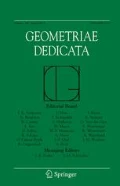Abstract
Let \(\mathbb{K}\) be an algebraically closed field and let G be a finite-dimensional algebraic group over \(\mathbb{K}\) which is nearly simple, i.e. the connected component of the identity G 0 is perfect, C G(G 0)=Z(G 0) and G 0/Z(G 0) is simple. We classify maximal elementary abelian p-subgroups of G which consist of semisimple elements, i.e. for all primes p ≠ char \(\mathbb{K}\).
Call a group quasisimple if it is perfect and is simple modulo the center. Call a subset of an algebraic group toral if it is in a torus; otherwise nontoral. For several quasisimple algebraic groups and p=2, we define complexity, and give local criteria for whether an elementary abelian 2-subgroup of G is toral.
For all primes, we analyze the nontoral examples, include a classification of all the maximal elementary abelian p-groups, many of the nonmaximal ones, discuss their normalizers and fusion (i.e. how conjugacy classes of the ambient algebraic group meet the subgroup). For some cases, we give a very detailed discussion, e.g. p=3 and G of type E 6, E 7 and E 8. We explain how the presence of spin up and spin down elements influences the structure of projectively elementary abelian 2-groups in Spin(2n, ℂ). Examples of an elementary abelian group which is nontoral in one algebraic group but toral in a larger one are noted.
Two subsets of a maximal torus are conjugate in G iff they are conjugate in the normalizer of the torus; this observation, with our discussion of the nontoral cases, gives a detailed guide to the possibilities for the embedding of an elementary abelian p-group in G. To give an application of our methods, we study extraspecial p-groups in E 8(\(\mathbb{K}\)).
Similar content being viewed by others
References
Adams, J. F., ‘Elementary abelian 2-groups in E 8(C)’, preprint (1986).
Alekseevskii, A. V., ‘Finite commutative Jordan subgroups of complex simple Lie groups’, Functional Anal. Appl. 8 (1974), 277–279.
Borel, A., ‘Sous groupes commutatifs et torsion des groupes de Lie compacts connexes’, Tohoku Math. J. (2) 13 (1961), 216–240.
Borel, A., et al., ‘Seminar on algebraic groups and related finite groups’, Lecture Notes in Math. 131, Springer Verlag, Berlin, 1970.
Borel, A. and Serre, J. P., ‘Sur certains sous groupes des groupes de Lie compacts’, Comment. Math. Helv. 27 (1953), 128–139.
Borel, A. and Mostow, G. D., ‘On semisimple automorphisms of Lie algebras’, Ann. Math. (2) 61 (1955), 389–405.
Chevalley, C., The Algebraic Theory of Spinors, Columbia Univ. Press, Morningside Heights, 1954.
Cohen, A. M. and Griess, R., Jr, ‘On finite simple subgroups of the complex Lie group of type E 8’, Proc. Symp. Pure Math. 47 (1987), 367–405.
Cohen, A. M., Liebeck, M., Saxl, J. and Seitz, G., ‘The local maximal subgroups of the exceptional groups of Lie type’, preprint.
Cohen, A. M. and Wales, D., ‘Finite subgroups of F 4(ℂ) and E 6(ℂ)’, preprint.
Curran, P., ‘Fixed point free action on a class of abelian groups’, Proc. Amer. Math. Soc. 57 (1976), 189–193.
de Siebenthal, J., ‘Sur les groupes de Lie compacts non connexes’, Comment. Math. Helv. 31 (1956), 41–89.
Gagola, S. and Garrison, S., ‘Real characters, double covers and the multiplier’, J. Algebra.
Gantmacher, F., Rec. Math. Moscou N.S. 5 (1939), 101–144.
Gorenstein, D., Finite Groupes, Harper & Row, New York, 1968.
Gorenstein, D. and Lyons, R., ‘The local structure of finite groups of characteristic two type’, Mem. Amer. Math. Soc. 42 (1983).
Griess, R. L. Jr, ‘Splitting of extensions of SL(3, 3) by the vector space \(\mathbb{F}_{\text{3}}^3 \), Pacific J. Math. 63 (1976), 405–409.
Griess, R. L. Jr, ‘Quotients of infinite reflection groupes’, Math. Annal. 263 (1983), 268–278.
Griess, R. L. Jr, ‘Sporadic groups, code loops and nonvanishing cohomology’, J. Pure Appl. Algebra 44 (1987), 191–214.
Griess, R. L. Jr, ‘A Moufang loop, the exceptional Jordan algebra and a cubic form in 27 variables’ (submitted to J. Algebra).
Griess, R. L. Jr, ‘Code loops and a large finite group containing triality for D 4’, from Atti Conv. Inter. Teoria Geom. Combin. Firenze, 23-22 Ottobre, 1986; Supplemento as Rend. Circ. Mat. Palermo, 79–98.
Griess, R. L. Jr, ‘The Friendly Giant’, Invent. Math. 69 (1982), 1–102.
Gruenberg, K., Cohomological Topics in Group Theory, Springer, Berlin, 1970.
Humphreys, J., Introduction to Lie Algebras and Representation Theory, Springer, New York, 1972.
Huppert, B., Endliche Gruppen I, Springer-Verlag, Berlin, 1968.
Kac, V. G., Infinite Dimensional Lie Algebras (2nd edn), Cambridge Univ. Press, Cambridge, 1985.
Kleidman, P., Meierfrankenfeld, U. and Ryba, A., ‘The Rudvalis group is in E 7(7)’, in preparation.
Lyons, R., ‘Evidence for a new finite simple group’, J. Algebra 20 (1972), 540–569.
McLaughlin, J. E., personal communication, 1975.
MacWilliams, F. J. and Sloane, N. J. A., The Theory of Error Correcting Codes, North Holland, Amsterdam, 1977.
Moody R. and Patera, J., ‘Characters of elements of finite order in Lie groups’, SIAM J. Algebra Discrete Methods 5 (1984), 359–383.
Robinson, D., ‘The vanishing of certain homology and cohomology groups’, J. Pure Appl. Algebra 7 (1976), 145–167.
Sah, C.-H., ‘Cohomology of split group extensions’, J. Algebra 29 (1974), 255–302.
Schur, I., ‘Über die Darstellung der endlichen Gruppen durch gebrochene lineare Substitutionen’, J. Reine Angew. Math. 127 (1904), 20–50.
Schur, I., ‘Über die Darstellung der endlichen Gruppen durch gebrochene lineare Substitutionen’, J. Reine Angew. Math. 132 (1907), 85–107.
Schur, I., ‘Über die Darstellung der symmetrischen und alternienden Gruppen durch gebrochene lineare Substitutionen’, J. Reine Angew. Math. 139 (1911), 155–250.
Springer, T. and Steinberg, R., ‘Conjugacy Classes’, Section E of [Bo2].
Steinberg, R., ‘Generators, relations and coverings of algebraic groups’, J. Algebra II 71 (1981), 521–543.
Wood, J. A., ‘Spinor groups and algebraic coding theory’, J. Combin. Theory (1989), 277–313.
Young, K. C., ‘Some simple subgroups of the Tits simple group, 72T-B263’, Notices Amer. Math. Soc. (1972).
Author information
Authors and Affiliations
Additional information
Dedicated to Jacques Tits for his sixtieth birthday
Rights and permissions
About this article
Cite this article
Griess, R.L. Elementary abelian p-subgroups of algebraic groups. Geom Dedicata 39, 253–305 (1991). https://doi.org/10.1007/BF00150757
Received:
Revised:
Issue Date:
DOI: https://doi.org/10.1007/BF00150757


